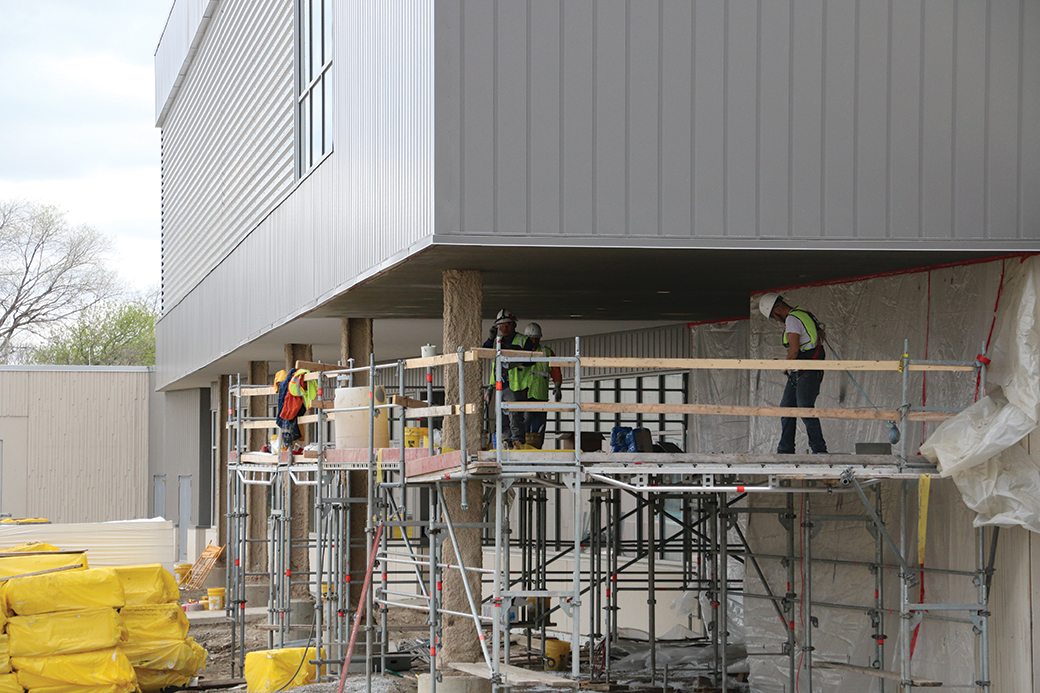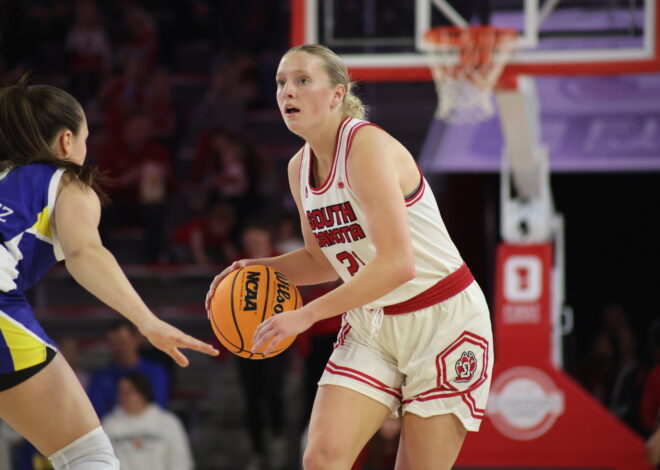
USD athletics department budgets for coming year, lack of GAF increase
In a small office tucked away in the bowels of the DakotaDome, Jeanette Hubert plans for the Athletic Department’s coming year.
Hubert, the Associate Athletic Director of Finance & Administration for USD, and her one assistant race against the clock every year to plan the department’s $12.9 million budget before July 1, the start of the new fiscal year.
Out of the $12.9 million, $4.3 million must be budgeted for student-athlete scholarships, something Hubert said is the largest bill the department has to pay for every year.
“We can’t use any university money for that,” she said. “It has to be through fundraising, guarantees and things like that.”
Guarantee money is money that other teams pay USD sports teams to come play against them. Football is the sport that brings in the biggest payday from guarantees. This year the team is traveling to Albuquerque to play New Mexico, a game that will bring in about $300,000.
Other teams also bring in guarantee money.
“Men’s basketball, we budget about $250,000 a year in revenue for them. That’s significant too. Women’s basketball too, but not as much,” Hubert said.
About $5.3 million of the $12.9 million budget comes from outside sources. Hubert said these sources include ticket sales, fundraising done through the USD Foundation, advertising revenue and NCAA revenue.
The expenses for the department are pretty consistent from year to year, she added.
David Herbster, the USD Athletic Director, said there are some things that are easily predictable for the coming year when preparing the budget, such as scholarships and personnel costs. The “moving target” for the department, however, is operating costs. These costs can be everything from how much it costs to keep the lights on to recruiting efforts.
“Your operating is everything else. It’s everything individually that goes into budgets,” he said. “It could be travel and it could be recruiting. Think about it, you have to pay officials. All of those different things of just operating on a daily basis.”
Herbster said sports teams will drive to games if the matches are within eight hours of USD. If the games are farther away, teams will fly. If the cost of traveling looks like it’ll be more expensive then what the department had originally planned, then changes have to be made to the scheduling of road games.
“If that travel is seemingly going to come in too much versus what we anticipated to allocate toward that line item in a particular sport then we make adjustments,” Herbster said.
These adjustments sometimes include rescheduling of games. Herbster said there’s always unanticipated expenses and the budget sometimes has to change to accommodate different circumstances.
“I say we do a pretty good job of being pretty close to the budget and proactive,” he said. “My mantra, and it’s kind of one that we use in the department, is that I look at this budget like I would be own checkbook and I’m certainly not going to bounce it. I can know on any given day how much I’ve got in there.”
Herbster added that when compared to other Division I schools, USD is pretty average when it comes to how big of a budget its athletic department has to work with.
“You look at the budgets all across the country and we have a $12 million budget and there’s North Dakota State who has a $18 million budget and SDSU has a $16 million. Then you have someone like Ohio State who has $140 million budget,” he said.
Part of the budget for this year already has to be reworked because of a recent South Dakota Board of Regents decision.
Last year the General Activities Fee (GAF) was raised, which was expected to generate more than $700,000 this year for USD. About $620,000 of this year’s GAF amount was slated to go to the athletics department, but due to the recent tuition freeze in the state, the GAF increase won’t happen and the department won’t be getting the money.
Hubert said she heard about the possibility before the final decision was made, so she’d already been adjusting the budget in case the GAF increase didn’t happen.
“We’re going back and refiguring,” she said. “We are opening an arena so we do have to prioritize what we’re looking at.”
The new arena and sports complex, recently named the Sanford Coyote Sports Center, is costing an estimated $66 million to build, with Sanford Health donating about $20 million toward the project.
Herbster said the department will be looking at ways to cut down on some expenses in order to compensate for the lack of additional GAF funding.
“It puts a very heavy burden on our revenue generation side,” he said.

